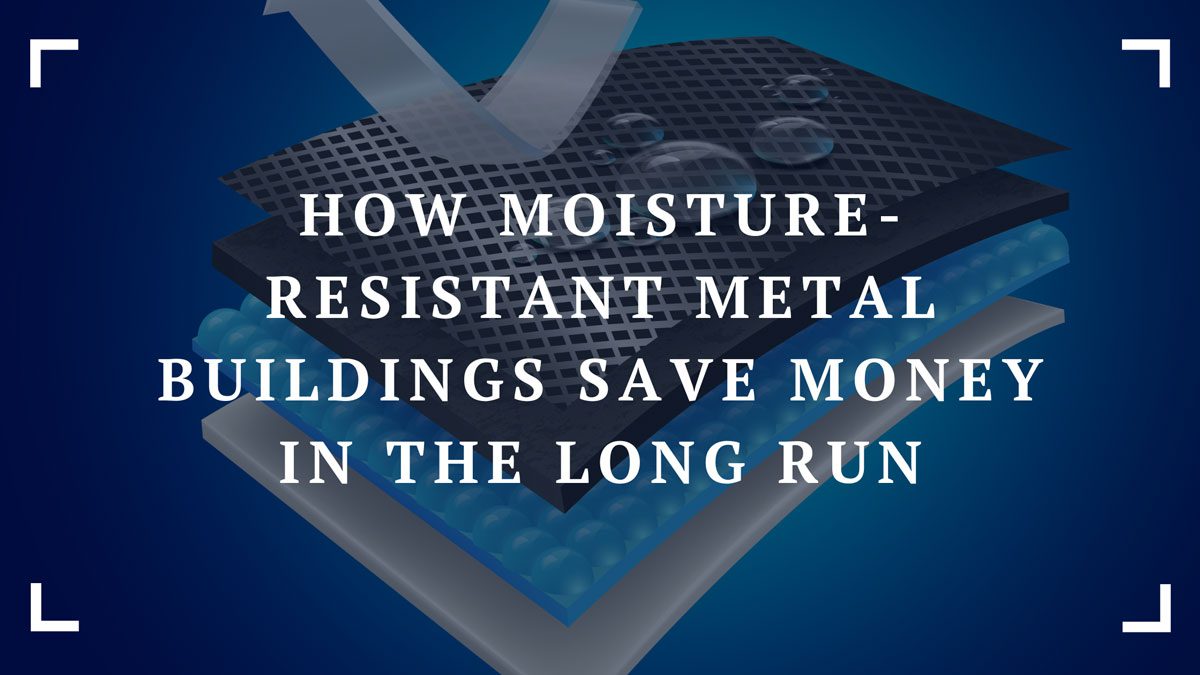When you have condensation, this is viewed as simply little water droplets. It’s not something that’s immediately damaging or a cause for concern, right? Well, this isn’t strictly true. Condensation is excess moisture and this is detrimental to metal buildings. While you might be looking to make expense cuts with your business, this shouldn’t be a topic that you skip. Let’s take a look at why you want your metal building to be moisture-resistant.

The Cost of Moisture Damage
Moisture damage can be a silent financial drainer lurking in the corners of your metal building. From corroded surfaces to structural decay, the repair costs can swiftly add up, leaving a dent in your budget. Understanding the potential financial repercussions is the first step in realizing the importance of moisture-resistant solutions. It’s not just about keeping the rain out; it’s about keeping the bills from pouring in.
The Role of Insulation
Enter one of the best solutions for moisture in a metal building. We’re talking about installing insulation. This acts as a barrier, which doesn’t allow moisture through and it helps to maintain a better and more controlled temperature. Together, the amount of condensation can be reduced, minimizing the risk of rust and damage. Check out bluetexinsulation.com if you want to purchase quality insulation for your property. This can be the first step in protecting your building and improving the conditions inside.
Energy Efficiency and Cost Savings
Picture this: a well-insulated, moisture-resistant metal building that not only keeps water out but also keeps your energy bills down. The synergy between moisture resistance and energy efficiency is the secret sauce. By maintaining a consistent indoor environment, your building becomes a fortress against both moisture and excessive energy consumption, resulting in tangible cost savings over time.
Longevity of Metal Structures
Moisture-resistant solutions aren’t just about immediate gains; they’re about ensuring your building stands strong for the long haul. A structure that withstands the tests of time reduces the frequency of replacements and major renovations. That’s a financial win – less money spent on rebuilding, more in your pocket.
Insurance Savings and Risk Mitigation
Speaking of pocket-friendly choices, moisture-resistant buildings often come with a bonus – reduced insurance premiums. Insurance companies recognize the lower risk associated with structures designed to resist moisture damage. By mitigating risks, you’re not just protecting your investment; you’re also enjoying the financial perks of potentially lower insurance costs over the years.
Tax Incentives for Moisture-Resistant Solutions
The government often rewards environmentally conscious choices, and moisture-resistant solutions may qualify for tax incentives or deductions. It’s like getting a financial high-five for making a smart, forward-thinking decision. Before embarking on your construction journey, explore potential tax benefits that could sweeten the deal even further.
The Hidden Savings: Health and Productivity
Now, let’s talk about the less obvious but equally impactful savings – the ones related to health and productivity. Moisture-resistant buildings create a healthier indoor environment by preventing mold growth and other allergens. Healthier occupants mean fewer sick days and increased productivity. It’s an indirect yet powerful way moisture resistance contributes to your financial well-being over time.
Maintenance Planning and Budgeting
Being proactive is key. When it comes to moisture-resistant metal buildings, effective maintenance planning and budgeting are your allies. Regular inspections, timely repairs, and a well-thought-out maintenance strategy contribute to a structure that not only stands strong against moisture but also avoids costly emergency fixes. By staying ahead of potential issues, you’re essentially saving for the future.
Why Condensation is Bad for Metal Buildings
Have you noticed some moisture in your metal building? Perhaps this started as a few droplets from the roof, but now it’s progressed and it’s really becoming a problem. The most important thing you can do is take it seriously. We’re not talking about getting the buckets out to catch the trips. We mean addressing the cause of condensation.
This can happen with fluctuating temperatures and metal buildings can be particularly vulnerable. But, it’s more just a little bit of moisture. Instead, it can cause real problems for your metal building. Let’s take a look at why condensation is so bad.
It Causes Rusting
One of the big dangers for metal buildings is rust. This is something that looks terrible. Nobody wants to see orange and flaky areas on the inside of their building. This is particularly true if you’re using it as a business premises. People work there, and it brings down the overall look.
However, rust isn’t just something that looks bad. It can also have an effect on the integrity of your building. Over time, the structure can be weakened by this corrosion, which can shorten its lifespan. This is not something you want, as metal buildings can be costly to repair.
Unsuitable for Storage
If you’re using your metal building for storage, this is not going to be the right environment if you have condensation. This is an indication of temperature changes and moisture in the air. Consequently, this could affect the items that you’re storing.
In addition, this environment will be perfect for mold and mildew. Consequently, this could damage your items further and make them unsuitable for selling or using.
Becomes a Health Risk
Let’s get back to the topic of mold and mildew. These are two substances that you don’t want in your metal building. They become a health risk for anybody that’s inside and especially if they become significant.
Unfortunately, if you’ve discovered condensation in your metal building, it’s inevitable that you’ll develop mold and mildew. This becomes a hazard for workers, which isn’t good for businesses.
Conclusion
It’s not just about building structures that resist moisture; it’s about making a wise financial investment. Moisture-resistant metal buildings go beyond immediate protection, offering a roadmap to long-term savings. From lower repair costs to energy efficiency, tax incentives, and improved health, the benefits stack up, creating a robust financial case for moisture resistance.


